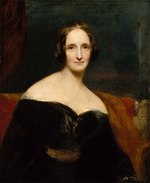Portal:Speculative fiction/Horror

Selected horror profile
Mary Shelley (née Mary Wollstonecraft Godwin; 30 August 1797 – 1 February 1851) was a British novelist, short story writer, dramatist, essayist, biographer, and travel writer, best known for her Gothic novel Frankenstein: or, The Modern Prometheus (1818). She also edited and promoted the works of her husband, the Romantic poet and philosopher Percy Bysshe Shelley. Her father was the political philosopher William Godwin, and her mother was the philosopher and feminist Mary Wollstonecraft.
Mary Godwin's mother died when she was eleven days old; afterwards, she and her older half-sister, Fanny Imlay, were raised by her father. When Mary was four, Godwin married his neighbour, Mary Jane Clairmont. Godwin provided his daughter with a rich, if informal, education, encouraging her to adhere to his liberal political theories. In 1814, Mary Godwin began a romantic relationship with one of her father’s political followers, the married Percy Bysshe Shelley. Together with Mary's stepsister, Claire Clairmont, they left for France and travelled through Europe; upon their return to England, Mary was pregnant with Percy's child. Over the next two years, she and Percy faced ostracism, constant debt, and the death of their prematurely born daughter. They married in late 1816 after the suicide of Percy Shelley's first wife, Harriet. Selected horror workNight of the Living Dead is a 1968 independent black-and-white zombie film directed by George A. Romero. Ben (Duane Jones) and Barbra (Judith O'Dea) are the protagonists of a story about the mysterious reanimation of the recently dead, and their efforts, along with five other people, to survive the night while trapped in a rural Pennsylvania farmhouse. George Romero completed the film on a US$114,000 budget, and after a decade of cinematic re-releases, it grossed some $12 million domestically and $30 million internationally. On its release in 1968, Night of the Living Dead was strongly criticized for its explicit content. However, in 1999, the film was selected by the Library of Congress for preservation in the National Film Registry as a film deemed "culturally, historically or aesthetically significant". Night of the Living Dead was cited by many as being a groundbreaking film; given its release during the Vietnam-era, due to perceived critiques of 1960s American society, historian Adam Rockoff described it as "subversive on many levels". Although it is not the first zombie film, Night of the Living Dead is the progenitor of the contemporary "zombie apocalypse" subgenre of horror film, and it influenced the modern pop-culture zombie archetype. Night of the Living Dead (1968), is the first of six Dead films directed by George Romero, and twice has been remade, as a film of the same name in 1990, directed by Tom Savini, and as Night of the Living Dead 3D in 2006. Horror topics
|

